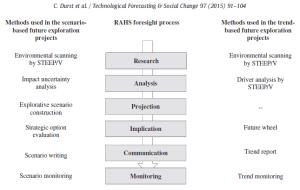12 February 2016:
Security-related future analysis is a core task of strategic planning at the German Federal Armed Forces.
In order to deliver a Risk Assessment and Horizon Scanning (RAHS) research and technology project with the objective to design, implement and test a web-based collaborative strategic foresight system, the project team conducted a comprehensive requirements analysis and assessed various existing software solutions.
The goal of the RAHS project included the delivery of a system that allows internal and external participants to select from a variety of individual and collaborative foresight methods, store information and results in a foresight database, and utilise project management functionalities.
As a foundation to deliver the project, the authors created a generic foresight model structure which includes four phases, namely a 1) information component (input: scoping and gathering information), 2) insight and understanding component (foresight: analysis, interpretation and prospection), 3) knowledge component (output: assessment and strategy), and 4) action component.
The developed IT supported foresight model allows a two stream approach (Fig. 1) for either scenario based or trend based projects. It provides 39 foresight methods, of which 18 methods are IT-supported and implemented within the RAHS system. 21 methods are not automated, but they are included in the system and users can download templates. Based on a questionnaire, one or multiple methods will be recommended by the system and can be selected for each phase of the process.

Fig. 1. Pre-defined method configurations (Durst, Durst, Kolonko, Neef & Greif 2015)
The foresight support system provides web-based support for group voting and will summarise the collaborative results (Fig. 2). So far, the system provided support for three foresight projects, namely “Peace Operations 2025”, “Air Traffic Growth, Energy and the Environment 2040”, and “The Future of Mobility – Scenarios for the United States in 2030”.

Fig. 2. Collaborative impact uncertainty matrix (Durst, Durst, Kolonko, Neef & Greif 2015)
The authors conclude that “the results are transparent and the foresight projects are executed more efficiently due to the integrated workflow and project management, which facilitate rules of order in foresight processes, the RAHS databases (factor database, trend database, scenario world and project archive) enabled the reuse of foresight results and collaborative features allow for more accurate and diverse input, including a structured consolidation process.”
Reference:
Durst, Carolin; Durst, Michael; Kolonko, Thomas; Neef, Andreas & Greif, Florian 2015: “A holistic approach to strategic foresight: A foresight support system for the German Federal Armed Forces”, Technological Forecasting and Social Change, vol. 97, August, pp. 91-104.
Link to full text article:
http://www.sciencedirect.com/science/article/pii/S0040162514000365
